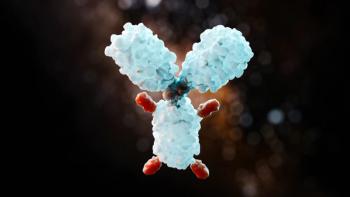
Researchers Close Knowledge Gaps on HIV Structure
Identification of the last unknown protein in HIV could lead to a cure for the virus.
A team of investigators recently determined the structure of the last unknown protein in
Understanding the structure of the cytoplasmic tail of the gp41 protein may provide insight into how HIV infects healthy cells, according to the study authors.
The authors also hypothesize that their discovery could help determine how progeny viruses are created and released from infected cells. The cytoplasmic tail is believed to be involved with virus assembly and adding the spike structure onto the surface of the virus, according to the study.
“If we are able to inhibit incorporation of the envelope protein, we inhibit viral replication,” said lead researcher Jamil Saad, PhD. “This would disarm the virus and prevent disease. The cytoplasmic tail is a critical component of infectivity.”
The authors said that determining the structure of the cytoplasmic tail was extremely challenging and other research teams were previously unable to do so.
Expressing the cystoplasmic tail of the protein in Escherichia coli cells presented a significant challenge, but ultimately was found to cut the protein during expression, according to the study.
“We have never seen this for any other protein,” Dr Saad said.
To overcome this issue, protein expression was restricted to only 2 hours. At that time, 70% of the tail was cut, with only 30% intact, according to the study.
Overall, determining the structure of the cytoplasmic tail of gp41 took 2 years and was studied under 100 different conditions.
The authors were able to use nuclear magnetic resonance to image the structure of a soluble piece of the tail, while they used micelles to let the insoluble portion of the tail to form its structure inside membrane-like conditions, according to the study.
The researchers then put the intact cytoplasmic tail into the micelle solution and discovered that the structures remained intact.
The N-terminal end of the cytoplasmic tail was observed to lack a secondary structure and was not associated with the membrane. Meanwhile, the C-terminal end was found to be highly associated with the membrane and had 3 alpha-helixes that were either hydrophobic or hydrophilic, according to the authors.
The authors report that knowing the structure of the cytoplasmic tail can result in novel research, including how it stabilizes and affects membrane stability of the envelope protein structure and how it coordinates membrane binding. These findings may also help determine the link to Gag polyproteins, which are crucial to the viral core of HIV, according to the study.
The identification of the cytoplasmic tail structure will also lead to comparative studies of other retroviruses, according to the authors.
Notably, the authors concluded that these findings could also lead to better HIV treatments and, potentially, a cure.
“The cytoplasmic tail of gp41 has been of interest for a long time, and nobody understands how it functions in infection or how it helps incorporate the envelope protein into the membrane,” Dr Saad said.
Newsletter
Stay informed on drug updates, treatment guidelines, and pharmacy practice trends—subscribe to Pharmacy Times for weekly clinical insights.
















































































































































































































